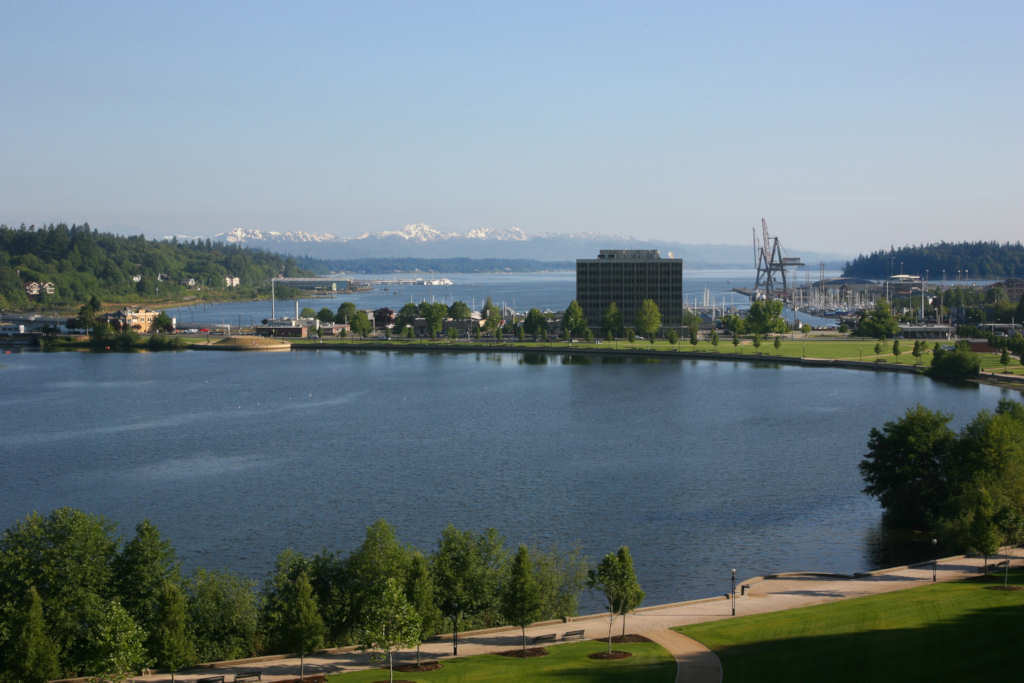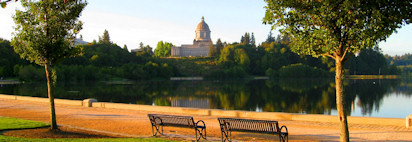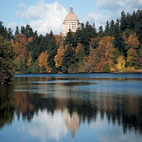15 Reasons Why Having Capitol Lake is Better Than Having an Estuary
Prepared by Dr. David H. Milne, PhD - June 2016
1. A lake has far more species diversity than does the head of an estuary.
If we destroy Capitol Lake, we will trade an ecosystem with many more species for an ecosystem with many fewer species.
This is widely known among estuarine ecologists and is documented in this author’s peer-reviewed paper: Capitol Lake - Healthiest Lake in Thurston County.
2. Capitol Lake provides habitat for a state listed "sensitive species", the Olympic Mud Minnow.
Destroying Capitol Lake would destroy a substantial share of this species’ total habitat in the Puget Sound basin
The Mudminnow is a unique species of fish that is found only in ("is endemic to") Washington state. Mudminnows live in Capitol Lake, Lake Ozette, and a lot of small watersheds on the slopes of the Olympics and around into the Puget Sound Basin. Capitol Lake at 270 acres probably exceeds the size of all of the rest of the east-side watershed habitats combined. Lake Ozette is by far the largest unit of habitat for this fish. Lake Ozette is approximately 7,800 acres, about 30 times the size of Capitol Lake.
National Park Service - Lake Ozette Wikipedia - Ozette Lake Wikipedia - Olympic Mudminnow
3. Capitol Lake has the best dissolved oxygen water quality of any monitored lake in Thurston County.
Estuaries naturally have seasonal low-oxygen bottom water. Destroying the Lake would replace a high-oxygen water body with a low-oxygen water body.
Nine other major lakes in Thurston County all have seasonal anoxic bottom water; Capitol Lake is the only one that has fully oxygenated bottom water all year long. The nine lakes in Thurston County known to this author to run out of oxygen at the bottom every summer are: Black, Deep, Hicks, Lawrence, Long, Pattison, St. Clair, Summit and Ward. Others – eg, Offutt – probably do, but they are not monitored by Thurston County. Low oxygen levels at heads of estuaries occur naturally, even in total absence of human contributions.
4. Capitol Lake’s excellent dissolved oxygen properties enable it to sustain very large populations of emergent aquatic insects.
These insects in turn sustain one of the largest colonies of Yuma myotis bats, ˜3000 animals, in the State of Washington. A tidal mudflat produces no emergent insects. Destroying the Lake might decimate the bat population and could cause abandonment of the colony.
The bats can’t simply move to another lake from their Woodard Bay colony because (1) all of the other lakes are farther from the colony than Capitol Lake, (2) the other lakes are almost certainly already fully utilized by other bat populations, and (3) the anoxic bottom water of the other lakes probably reduces the populations of bat-resource emergent insects that can complete their life cycles there.
5. Destruction of Capitol Lake could have a negative impact on two state listed "candidate species".
These "candidate species" are the purple martin and Vaux’s swift. These birds share the emergent flying insect food resource with the bats. A tidal mudflat couldn’t support the bats or probably any other aerial feeders like swallows, swifts, & martins at present population levels.
See Table 2 in Hayes et al 2008 (CLAMP Report) showing Vaux’s swift as "very negatively" impacted. The CLAMP Report pg 13, see pg 18 of the 98 pg PDF
6. Although Capitol Lake is on the EPA’s 303(d) list, so are seven other Lakes in Thurston County.
Many saltwater sites in Budd Inlet are also on the 303(d) list. Replacing the Lake with a tidal mudflat will not reduce the size of the EPA’s list.
The other lakes on the 303(d) list are Black, Lawrence, Long, Pattison, Summit, Ward and Offutt Lake. There are perhaps 20 Sites in Budd inlet that are also on the list. (The Author has not counted them but the red spots on the map make it look like Budd Inlet has measles. Most of the Listings, including Captiol Lake’s, are due to excess phosphorus in the water, some but not Capitol Lake’s, are due to the occurrence of organic chemical contaminants in fish, and only one (Capitol Lake’s) mentions "bacteria."
7. An estuary would have at least as many introduced species in it as Capitol Lake and probably more.
One of them would be the New Zealand Mud Snail. Destroying the Lake would not reduce, and would probably increase, the number of introduced species living in that basin.
Capitol Lake has about 12 introduced species in its waters. Budd Inlet also has at least 12 introduced species in its waters. There are many more known from Totten Inlet and other nearby waters that will surely occupy Budd Inlet in the future, if they haven’t already done so. Estuaries are hotbeds of marine invasive species; a fact apparently not known to the estuary advocates.
Introduced species listed for Capitol Lake are New Zealand Mud Snail, bullfrog, nutria, common carp, brown bullhead, large- & small-mouth bass, yellow perch, Eurasian water milfoil, Asian clam Corbicula, “big-eared radix” snail, and fragrant water lily. Milfoil has probably been eliminated by a biological control program; large-mouth bass has not been seen in recent decades. It is surprising that Hayes et al (2008; CLAMP Report) did not list the introduced species in Budd Inlet. Introduced species in Budd Inlet are known to include Pacific oyster, manila clam, eastern soft-shell clam, Atlantic slipper limpet, Japanese oyster drill, Atlantic oyster drill, Baltic macoma clam, lined sea anemone, European moon jellyfish, snails Assiminea californica and Myosotella myosotis, Japanese Sargassum weed, and European mussel. There are surely another dozen saltwater species, known from Eld and Totten Inlets, that lap over into Budd Inlet but no one has bothered to report them.
8. Capitol Lake prevents about 20 tons of nitrogen nutrients from entering Puget Sound every summer.
A tidal basin replacing the Lake would enable this nutrient tonnage to go directly into the Sound, lowering or eliminating dissolved oxygen at the bottom.
The estuarians’ last hope is that DOE can "prove" that the intercepted nitrogen nutrients ultimately lower DO in Budd Inlet by creating dead plants in Capitol Lake that go over the dam and decay. This doesn’t happen. After the growing season ie: November, the captured nitrogen stored in lake plants makes its way to West Bay when the plants die back and decay – too late to affect bottom water DO’s. The Lake mitigates some, or all, of the negative effects on Puget Sound of the nutrients carried by the River.
9. A Lake can support swimming, fishing, kayaking, wading, water skiing, Lake Fair floats and sailing recreation 24 hours a day during summer. A brackish tidal basin cannot.
The Lake has met swimming coliform and clarity standards for the last 15 years.
If the Lake is replaced by an estuary, the basin in front of the Capitol will be mostly mud during the midday daylight hours during the spring and summer. With the Lake it is always a recreational reflecting⁄swimming⁄boating⁄fishing⁄wading basin, 24⁄7. Access to salt water for most recreational activities is difficult at best. Even at high tide, few people swim in brackish water, compared with swimmers in fresh water.
10. Destroying the Lake will not remove the need for dredging.
If the dam is removed, for starters nearly one and a half million cubic yards of sediments now situated in the Lake will have to be dredged and removed. After that, sediments now trapped by the lake will simply move out into West Bay, mingle with contaminated sediments already there, and still require dredging and disposal.
Some of the sediment escapes to Budd Inlet even with the dam in place. The yacht club members recently in 2015 spent nearly one million privately funded dollars dredging and removing sediment from the bottom under their docks and floats. Much of this price tag was due to the high cost of proper disposal of contaminated sediments. (See next item.)
11. Thirty-five thousand cubic yards of clean Capitol Lake sediment dredged every year might have a market value of about half a million dollars. Contaminated dredged sediment from an estuary would have annual dredge and disposal costs of about 4.5 million dollars.
Good soil, "sandy loam mixed with compost", sells for about $15 per cubic yard. Contaminated estuarine sediment costs about $100 per yard for safe disposal. The estuary sediments are contaminated with PCB’s and other compounds left over from creosoting and other activities on the waterfront. If the dam is removed and the clean river sediments enter the estuary, those sediments will likewise be commingled with contaminated ones, as was the case at the yacht club.
12. Because of prevailing NW winds and low tides during daylight hours during summer, tideflat hydrogen sulfide odors are likely to be more prevalent throughout Olympia and Tumwater during summers if a tidal basin replaces the Lake.
The tide regime is such that high tides are mostly at night during spring and summer, and low tides mostly occur during the day. The opposite is true during fall and winter. During summers, prevailing winds tend to be from the northwest. This combination, with summer heat, means that windborne odors would almost certainly be more frequent and prevalent downtown than at present if an estuary replaced the Lake
13. The managed Lake can help protect the downtown area from flooding episodes during periods of high rainfall and runoff, low atmospheric pressure, and extreme high tides.
A tidal basin cannot provide any such protection.
Apparently leaving the tide gates open was tried during the 1950’s as a way of mitigating flooding in Olympia. According to Engstrom-Heg (1955), it was discovered that closing the tide gates after draining the Lake was a more effective strategy for receiving and releasing flood water and mitigating flooding. (Engstom-Heg, R. T. 1955). Environmental relationships between young Chinook Salmon in Capitol Lake and the Deschutes River system. Report to WA. Dept. of Fisheries. 80 pp.
14. Most people in Olympia would rather have a Lake in front of the Capitol than a tidal mudflat.
Each of five candidates for public office who collectively door-belled over 10,000 homes between 2010 and 2013, reported an "overwhelming" percentage of people in the homes in favor of retaining Capitol Lake. The candidates were Chris Reykdal, Karen Rogers, Allen Miller, Sheryl Selby, and a "Mr. Hall". [Interviews with candidates conducted, and info provided, by CLIPA.] A candidate for public office who interviewed 4000 residents in 2016 found that only 10 of them favored replacing the Lake with an estuary. (Miller, pers. comm., 2016.)
15. In 2012, the Department of Ecology’s computer model showed that the worst negative effect of Capitol Lake on Budd Inlet is so small that it’s not measurable.
Destroying the Lake won’t help Budd Inlet.
This is shown by Figure 90 in the DOE’s "TMDL Report" (Publication No. 12-03-008, published in 2012). When the author called attention to this in 2013, DOE staff scrambled to "fix" the model and voila! "found" that what the model really calculates is that Capitol Lake harms almost all of Budd Inlet, a lot!!
Speaking of which, there are at least five mistaken ways in which this model is being used to damage Capitol Lake’s reputation. 1) It reports changes in surface oxygen that have nothing to do with critical conditions at the bottom or water quality in general; 2) It gets “wrong answers” in about 50% of the cases in which the “right answer”, measured DO level in Budd Inlet, is known; 3) It can’t distinguish between possible Capitol Lake effects and possible large local effects of Moxlie Creek; 4) It produces demonstrably wrong predictions of oxygen levels in Capitol Lake; 5) despite the fact that its predictions of DO levels miss about half of the hundreds of known “calibration” DO levels in Budd Inlet by wide margins, its users claim pinpoint accuracy.
But all of this is another story, told in this author's report "Capitol Lake and Puget Sound. An Analysis of the Use and Misuse of the Budd Inlet Model."
There are many more than 15 reasons why Capitol Lake is a better environmental alternative than an estuary. Here’s an example:
16. One "Dual Basin Alternative" that preserves Capitol Lake has been identified. That is, leave the Lake as it is and re-route Percival Creek to flow along the west side of the Deschutes Parkway directly into West Bay, thereby restoring the Percival Creek estuary and its anadromous fish habitat while preserving the Lake.
This “Dual Basin” alternative is one of several; another is an impoundment coupled with dam removal proposed by a local community advocate, termed “DELI.”
There is not even one scientifically demonstrable way in which the headwaters of an estuary improve the environment of Puget Sound and specifically the Budd Inlet estuary more than does Capitol Lake.
Although estuaries are typically very productive environments in most cases, the headwaters of estuaries (which is what the estuary proponents are advocating) are typically very species-poor and unproductive environments. As a very eutrophic Lake that is constantly fed a huge nitrogen nutrient supply by the Deschutes River, Capitol Lake is probably as biologically productive as almost any estuary anywhere. Increasing the productivity of the main estuary Budd Inlet, which is already so “productive” as to endanger its deep-water oxygen supply, would probably degrade its already precarious deep oxygen supply even further in late summers.
15 Reasons Why Having Capitol Lake is Better Than Having an Estuary
Dr. David H. Milne, PhD


